
According to nonprofit fundraising reports, corporate giving is one of the largest sources of financial support for charitable organizations and other mission-based initiatives. Thus, it’s essential that fundraising groups have dedicated strategies in place for making the most of the opportunities available to them.
While a hefty sum is contributed through workplace giving programs like matching gifts and corporate volunteerism, other substantial sources include community grants, sponsorships, and more.
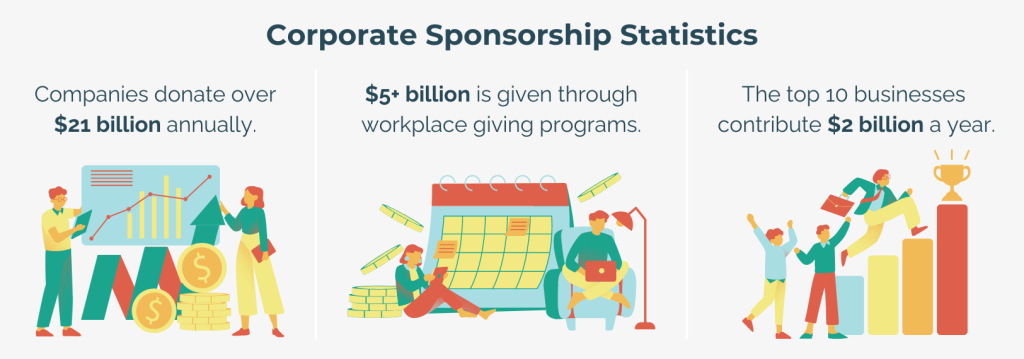
In this guide, we’re diving deep into the realm of broader corporate sponsorships. We’ll cover what it means for organizations like yours as well as actionable practices for developing the most impactful business partnerships for your cause.
And it all starts with these simple steps:
- Form a volunteer-led sponsorships committee.
- Identify companies to pursue partnership opportunities.
- Leverage corporate giving software to inform sponsorship efforts.
- Define specific criteria for corporate sponsorships.
- Establish strategic value-adds to offer corporate partners.
- Steward and grow sponsor relationships.
Ready to uncover and secure top-notch sponsors for upcoming events and fundraising campaigns? Let’s get started with the basics.
What are corporate sponsorships?
Corporate sponsorships provide nonprofits and education institutions with unique opportunities for financial support, heightened reach, and more.
But what exactly is a corporate sponsorship?
A corporate sponsorship is a collaborative initiative between a charitable organization and a business in a way that benefits both parties. In other words, it’s a mutually beneficial partnership through which a company supports a specific nonprofit event or project.
These kinds of partnerships can come in a few forms:

- Financial — A business provides a monetary contribution that helps finance a nonprofit’s upcoming project or event. This allows organizations to offset the costs of event hosting, ultimately allocating more funds to the nonprofit’s mission.
- Ex: Company A donating $10,000 to support an annual fundraising gala for Nonprofit A
- Workplace giving — A business encourages its employees to support a nonprofit’s upcoming event or project by providing an incentive for doing so. This empowers the company’s staff to get involved, supplies the organization with new supporters, and produces additional funding.
- Ex: Company B matching the fulfilled pledges its team members collect through a run/walk/ride event supporting Nonprofit B
- In-kind — A business supplies non-monetary donations that go toward a nonprofit’s upcoming event. This enables the organization to minimize its own funds going into the program, thus increasing its ROI.
- Ex: Company C providing food supplies and catering services for a benefit dinner hosted by Nonprofit C
- Media — A business covers the costs associated with promoting a nonprofit’s upcoming event through paid marketing channels. This allows the event to be more heavily marketed without the costs of doing so cutting into the organization’s returns.
- Ex: Company D purchasing a $5,000 television advertisement for a fundraising campaign organized by Nonprofit D
Regardless of the type, the processes involved with sourcing the best sponsors generally follow a similar flow. And that brings us to our first recommended practice!
1. Form a volunteer-led sponsorships committee.
Establishing a sponsorships team is one of the first steps any organization should take to scale up its corporate partnerships.
While staff members bring professional expertise, a committee driven by passionate (and well-equipped) volunteers adds a personal touch to your sponsorship outreach efforts that can go a long way.
Why? As unpaid advocates of your cause, volunteers can convey a level of authenticity and dedication that salaried team members simply cannot. And it often resonates with potential sponsors, thus fostering trust and increasing their likelihood of engagement.
In terms of this committee’s ideal makeup, we recommend forming a group of 4-6 individuals familiar with your organization and its mission. This ensures a well-rounded team with diverse knowledge, experiences, and perspectives. And it ultimately expands the reach and effectiveness of your sponsorship outreach.
Keep in mind that various backgrounds and skills can shape your team’s efforts. When possible, consider representatives who may align with the following categories:
- Individuals with expertise in marketing, communications, or community engagement
- Current and former members of your organization’s board of directors
- Those who have previously taken on volunteer leadership roles in your organization
- Supporters with industry-specific knowledge of your nonprofit’s mission
- Experienced peer-to-peer fundraisers
- Well-connected community members with established and widespread networks
- Donors or volunteers who have experience participating in their employers’ workplace giving programs
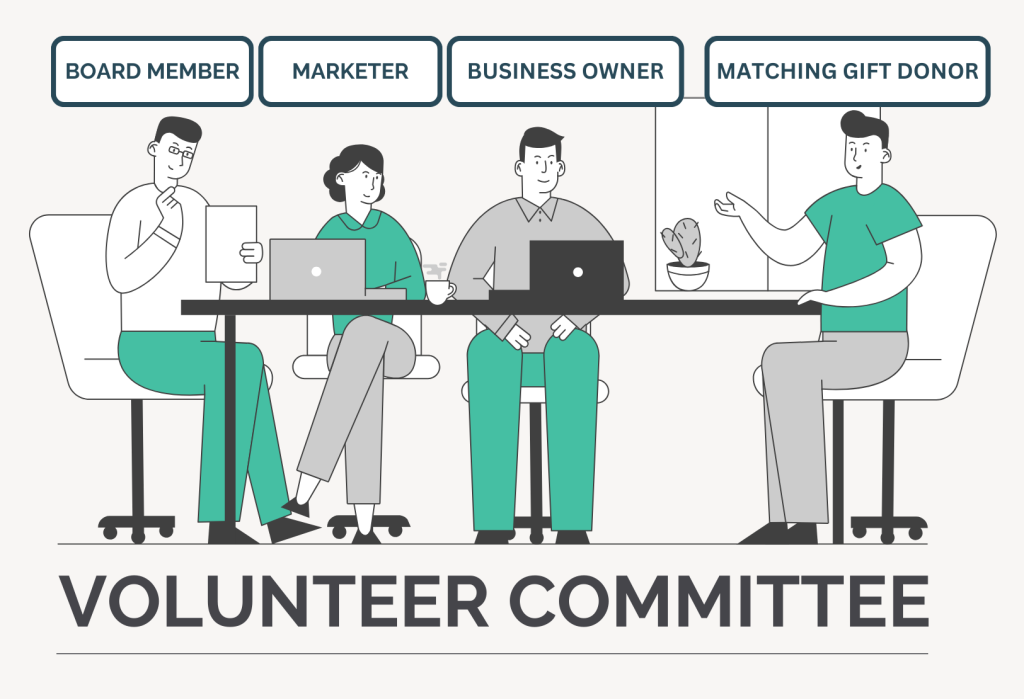
Keep in mind that a sponsorship outreach role can seem quite daunting for a volunteer with little to no experience in the realm. As you invite individuals to join the committee, assure them that they’ll receive valuable training, resources, and support from your team every step of the way. Then, ensure your staff follows through with the promises throughout the process!
2. Identify companies to pursue partnership opportunities.
Before diving into the sponsorship asks, it helps to devise a strategy for locating prospective sponsors. Here are a few best practices to follow as you do so:
Make a wishlist of businesses you’d like to work with.
Set your volunteer team up for success by providing a lengthy list of prospective companies with which they can engage. We suggest incorporating a combination of local businesses, larger companies, and other well-known examples of corporate social responsibility. There are pros and cons to each type!
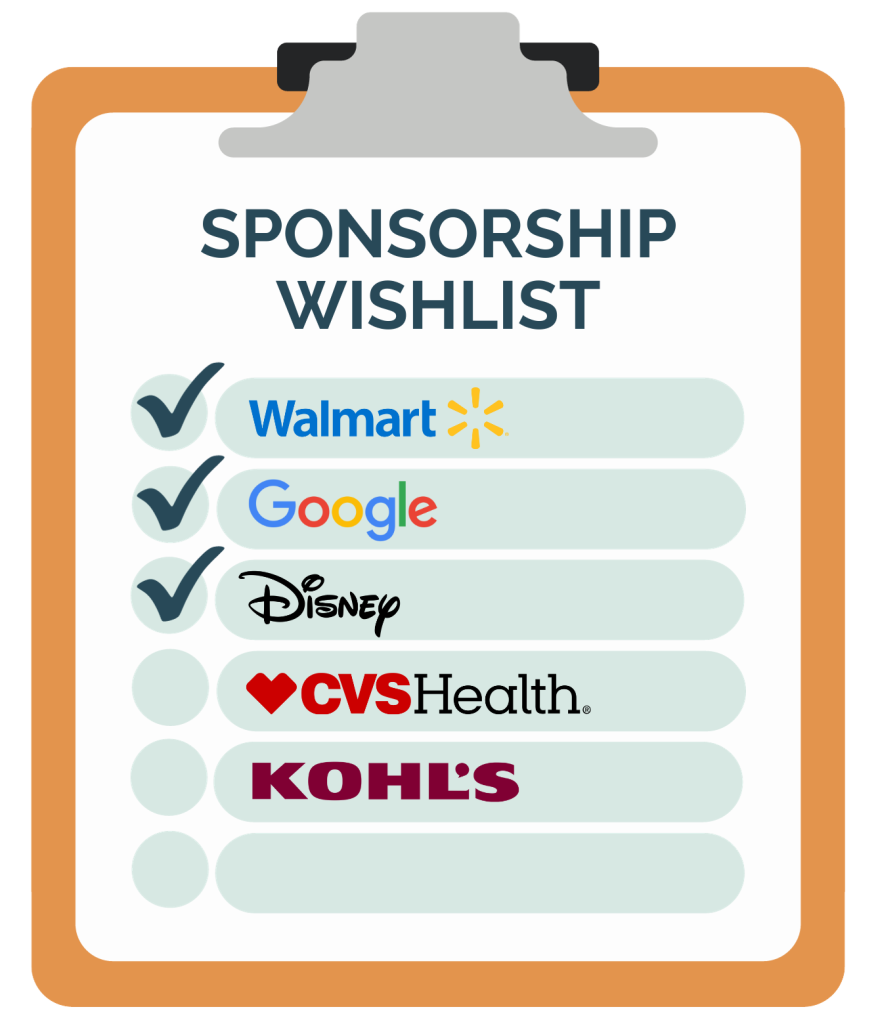
After all, businesses in your community may be more inclined to play a role in giving back. They have a direct stake in community well-being, and supporting organizations that operate in their own backyards allows them to make a more immediate and tangible impact. Plus, they’re more likely to have a local workforce they can engage alongside your organization’s event.
At the same time, larger chains tend to have more available resources devoted to corporate giving and extra room in their budgets to contribute. Thus, the right combination of each can go a long way!
Top tip: When it comes to national chains and other commercial enterprises, we suggest pursuing those that are well-known for donating to nonprofits.
Ensure potential sponsors align with your own values.
Corporate sponsorships can be extremely beneficial for both the companies and the nonprofits that participate. It’s important to note, though, that such relationships thrive when there is a strong alignment between the receiving organization and the sponsoring business.
In other words, it’s in both parties’ best interest to prioritize relationships with complementary partners.
For example, if you see a possible corporate partner has business values that clash with your core mission (e.g., a tobacco company and a cancer research organization), it’s typically better to move on. You’ll find a better fit elsewhere without compromising your ideals!
Note companies that sponsor similar organizations.
Take a page from other nonprofits in your area (or even worldwide, thanks to the shrinking world theory) to see what they’re doing in terms of corporate sponsorships.
For instance, suppose you work at a Humane Society, and you see another county’s animal shelter hosting a gala sponsored by their local Publix. In that case, you might want to prioritize Publix outreach for your own upcoming event.
Alternatively, you might read a case study that showcases how a global pharmaceutical company supports a number of healthcare organizations. As a result, you decide to pitch a sponsorship to the company for your nonprofit clinic.
This allows your team to gain inspiration while also noting businesses that are particularly agreeable to nonprofit partners. Plus, you can better understand and keep up with industry trends.
Do more small businesses seem to be getting involved in corporate social responsibility? Reach out to those in your community! Are companies putting more of their philanthropy budgets toward workplace giving initiatives? Empower your donors to advocate for engagement opportunities to their employers on your organization’s behalf!
3. Leverage corporate giving software to inform sponsorship efforts.
Corporate giving software (such as your matching gift database and automation solution) is a powerful tool. And many organizations already have it in their technology arsenal as a way to identify and pursue corporate matching gifts. But did you know nonprofits can also use it to guide their sponsorship efforts and establish meaningful corporate partnerships?
When it comes to identifying potential sponsors, one of the best things your team can do is to locate relevant connections in your database. After all, an existing relationship with a business—or someone within the business—might be exactly what you need to capture the right person’s attention. It can even help you get your foot in the door to begin a sponsorship conversation!
For example, do you have a lot of matching gift donors who work for a company that offers a particularly generous giving program? Or a group of dedicated volunteers employed by the same local business? These might be some of the best places to start your sponsor search! Leveraging your commonalities (your supporters and their staff) can demonstrate the value of a possible partnership right off the bat.
And your corporate giving solution plays a crucial role.
It already collects employment information from donors as they give to your organization. This data is then stored in your matching gift solution, ready for your team to make the most of the insights it provides!
Plus, if you use the industry’s leading matching gift database, Double the Donation, it even compiles the data in a user-friendly reporting dashboard:
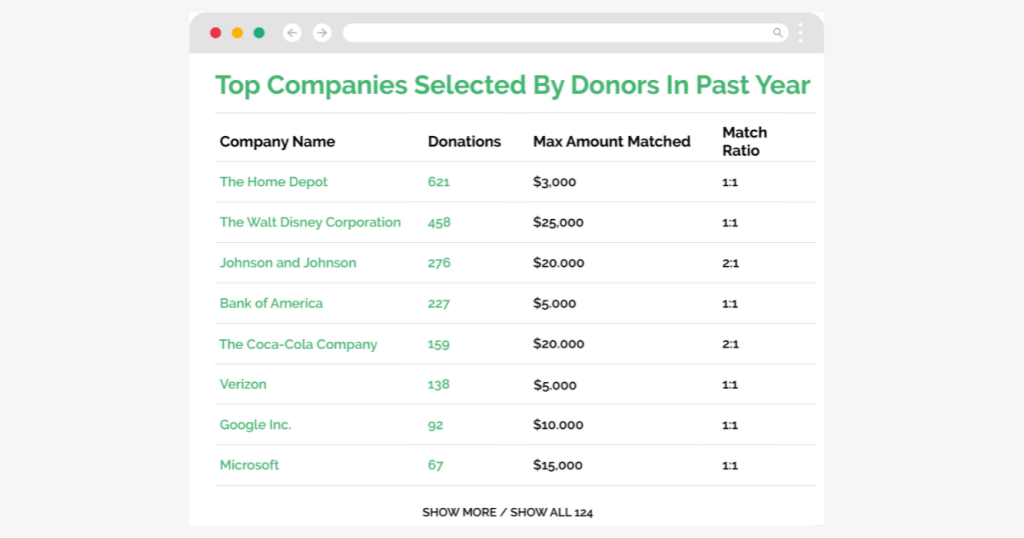
From there, you can determine which companies best fit your ideal sponsorship model, and initiate outreach accordingly.
Remember: by showcasing shared audiences and the dedication its staff has to your cause, your targeted pitch becomes significantly more compelling. Throw in a few statistics referencing the relationship between corporate giving and employee engagement to help seal the deal! (Here’s an example: 71% of employees say it’s very important to work at a company that gives back.)
You can also encourage donors to play a direct role in advocating for sponsorships to their employers on your behalf. This might mean facilitating a warm introduction between your organization and their employer—or even making the pitch themselves.
Don’t have a corporate giving platform yet?
Get a demo of our recommended solution, Double the Donation!
4. Define specific criteria for corporate sponsorships.
At this point, you should have an extensive list of prospective partners. Now, it’s time to move on to the ask!
However, the idea of a “sponsor” can be pretty vague—and there’s no one-size-fits-all model for corporate sponsorships. As a result, it helps to define exactly what you’re looking for when planning and approaching potential partners.
Keep in mind that this will vary based on the type of event or campaign you’re holding. For example, the items your team requests for a charity auction will not be the same as what you might seek for an upcoming walk-a-thon.
Regardless, here are some common examples of sponsorship asks:
- Cash gifts
- Scholarship or grant funding
- Gift cards
- Auction items
- Raffle items
- Employee giving or fundraising matches
- Food and beverage supplies
- Technology or other equipment
- Meeting space
- Volunteer teams
- Catering services
- Transportation services
- Printing services or materials
- Product samples or giveaways
- T-shirts or other branded apparel
Regardless of the specific ask, it’s important to offer a wide range of sponsorship packages in order to appeal to businesses of all shapes, sizes, and budgets. Your local mom-and-pop restaurant likely wouldn’t be able to give at the same level as a well-to-do international chain. But you don’t want to exclude any amount of support for your cause!
Once you’ve determined exactly what you’re looking for, consider implementing a multi-tier sponsorship package system. This allows for a straightforward ask and ensures your team is transparent about its opportunities for involvement.
5. Establish strategic value-adds to offer corporate partners.
Corporate sponsors want to benefit the nonprofits they’re supporting and the missions those organizations serve. But, in order to drive business value, they want to receive something in return. That “something” is referred to as the nonprofit’s value proposition or value-add. And a big part of a successful sponsorship pitch is making a compelling case for the value-add your team can offer.
A value proposition might encompass tangible perks like these:

- Co-marketing opportunities, including flyers, posters, and social media posts
- Logo placement in event signage and other materials
- Acknowledgments in event programs, ceremonies, or remarks
- Media coverage through press releases, interviews, advertisements, and more
- Dedicated exhibition space, product placements, or interactive displays
- Engagement opportunities with potential customers in their target market
- Exclusive access to high-profile networking events
- VIP tickets, backstage access, and other premium experiences
- Detailed analytics and insights into ROI, brand sentiment, and more
However, the benefits you offer should be adjusted to fit your organization, its audience, and the type of event you plan to host.
When you’re ready to finalize your pitch, consider aligning your outlined proposition with the various tiers of support you’ve already developed. Here’s an example:
Tier |
Contribution |
Recognition |
Benefits |
|---|---|---|---|
Platinum |
$10,000 and above | Prominent logo placement on all marketing materials, VIP access to special events and key sessions. Dedicated exhibition space at the event venue. Inclusion in attendee gift bags. | Opportunity to address attendees during opening or closing ceremony. |
Gold |
$5,000 – $9,999 | Logo placement on event signage and select marketing materials. Priority seating at key event sessions. Shared exhibition space at the event venue. | Acknowledgment during the event’s opening or closing remarks. |
Silver |
$2,500 – $4,999 | Logo placement on select event materials and signage. Listing in press releases and media coverage. Shared booth space at the event venue. | Acknowledgment in the event program. |
Bronze |
$1,000 – $2,499 | Company name on select materials and signage. General admission to event sessions. Shared promotional space at the event venue. | Listing in the event program. |
Not to mention, there are also the more abstract benefits of participating in sponsorships. These may include enhanced corporate social responsibility, employee engagement, community engagement, brand reputation, and more. While less tangible—and offering less direct ties to your specific partnership—these advantages can certainly help sweeten the pot in your sponsorship conversations!
When companies see significant returns on their philanthropic investments, they’ll be more inclined to continue supporting your organization in its endeavors to come. And at the same time, your team will attract new sponsors looking to reap the same sorts of value.
6. Steward and grow sponsor relationships.
Once you’ve secured support from a sponsor (whether a cash donation, gift-in-kind, workplace giving initiative, or anything else), don’t make the mistake of letting that partnership fall by the wayside. Instead, make an intentional, ongoing effort to grow your corporate relationships and sustain your success in the long run.
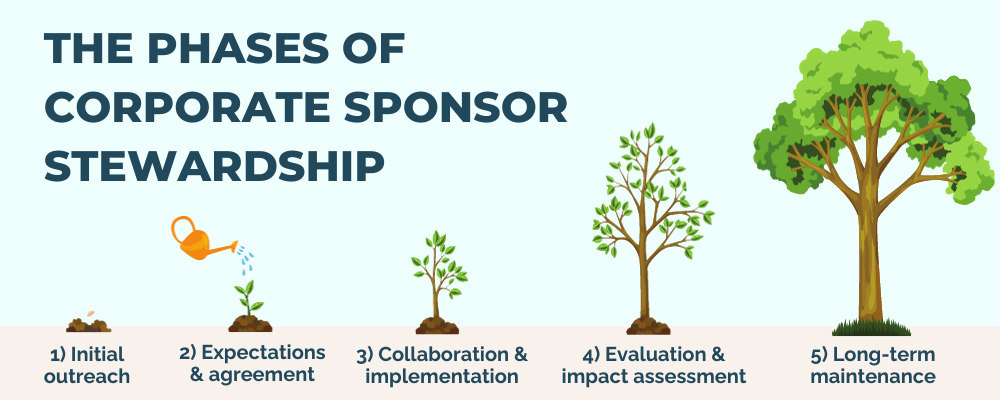
Doing so typically involves:
- Expressing genuine gratitude for your sponsor’s generosity;
- Publicly acknowledging your sponsor’s support (ideally above and beyond what was established in your agreement);
- Gathering feedback regarding the partnership and the event the company sponsored;
- Assessing and demonstrating tangible impact with metrics, success stories, and other positive outcomes;
- Sharing additional ways to stay engaged, including recurring sponsorship opportunities, custom matching gifts, and more;
- Discussing ongoing goals, visions, and strategies;
- And more.
Be sure to tailor your stewardship plan based on the sponsor’s priorities and objectives, too. While some sponsors value visibility through marketing efforts, others may prioritize employee engagement or social responsibility. Customizing your recognition demonstrates attentiveness to the sponsor’s goals and preferences, and ultimately enhances the overall partnership experience.
In the end, the goal is to create lasting value for both your organization and the company that funded your initiative. By implementing these practices, you might just end up with a recurring sponsor for your next annual event!
Final Thoughts
Corporate sponsorships are widely available to nonprofit organizations such as yours—you just need to know where to look. Start at the beginning and work through the steps outlined in this guide to uncover valuable corporate partners that are eager to support your team and its mission. Good luck!
Dive deeper into corporate giving and the benefits it can bring your organization with our other impactful guides:
- Common Matching Gift Obstacles—and How to Solve Them! Few organizations truly maximize their matching gift potential. Explore some of the most frequent roadblocks to effective matching gift fundraising and the easy solutions in this guide.
- 4 Best Ways to Maximize Your Employer Append Records. Knowing where your donors work can help uncover valuable opportunities for corporate sponsorships and more. Check out these smart tips for locating employment information with data appends.
- Understanding the Matching Gift Disbursement Process. Do you really know what goes on behind the scenes of a matching gift donation? Detailing the process can help your team prepare and optimize its corporate giving strategies. Find out more here!
